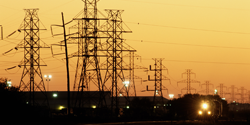Power Generation
Power Generation

Power Generation and Smart Grid
This research report, drafted by the Commission, focuses on analyzing the current state of energy efficiency within the power generation area and the challenges of modernizing the United States’ electrical grid and the potential of these energy updates as means to help reach the goal of doubling energy productivity by 2030.
Introduction/Background
The United States’ electric power system (EPS) is a vast physical and human network of centralized and distributed power generation connecting power between millions of customers and end-use applications. To meet growing and evolving energy demands, the electric grid must be updated in such a way that integrates a two-way flow of information and power to and from the customers while still providing a service that is affordable and reliable. This can be achieved through the Smart Grid, which can improve the electric power infrastructure, create more resilience to outages and security threats, lower operating costs, and allow the integration of cleaner power sources.
Investment
In order to effectively increased energy productivity in the electric utility sector, investment strategies should aim for greater efficiency in energy production and delivery, and greater end-use efficiency. A 2011 report by the American Society of Civil Engineers estimated that in order to keep up with electricity demand, increases in generation, transmission, and distribution capacity, cumulative investments of $107 billion by 2020 and nearly $732 billion by 2040 would be required. Investments in energy efficiency certainly pay off, as shown by the benefits of rate payer-funded electric efficiency and load management programs. These have produced estimated savings of approximately 112 billion kWh of electricity in 2010, enough to power nearly 10 million homes or nearly 3% of United States' end-use electricity consumption in 2010.
Technology
There is a wide array of technological advances – particularly in power generation – with the potential to increase energy efficiency. 60 to 65% of the energy stored in fuels is lost in the fuel-to-electricity conversion process. Improvements can be made in areas such as electrical distribution, steam plant heat rates, and transmission. Electrical distribution systems, for example, show energy losses of 3-7%, and transmission losses are estimated to be 3% of total energy generated in the electricity sector. The accumulation of recovering these small percentages can be very meaningful given the amount of total energy lost in the system.
Human Behavior
Changes in consumer present an emerging opportunity to explore new energy efficiency strategies. These changes can better enable customers to manage their electric consumption and ultimately their bills, though transforming consumer behavior can be challenging. Even so, behavior-based efficiency programs can improve efficiency gains above normal productivity improvements in the economy. However, the estimated extent of these gains ranges dramatically from 2-3% savings realized through actual results of behavior based programs occurring in the United States today (based on efficiency program results) to an American Council for an Energy-Efficient Economy.
Governance
All levels of government have an important role to play in advancing the efficiency of the nation’s electrical grid and power generation systems. States, as the primary regulators of the electric power sector, should work to integrate distributed power supplies, and the federal government should work to invest in research and development efforts and to regulate interstate energy transmission. With the Department of Defense as the nation’s single largest user of energy, using more than 1% of the nation’s total energy supply, the federal government must also work to lead by example.
Barriers
Many common barriers interfere with the goal of increasing energy efficiency in the power sector. These can occur at the utility level, where market volatility, regulatory barriers and uncertainty might deter investments, or at the consumer level, where a lack of detailed energy-use data prohibits a comprehensive understanding of electricity consumption patterns and limits the opportunity to adjust those patterns.
Opportunities
Energy efficiency opportunities in the power sector range from investing in Smart Grid technologies to decreasing energy loss in power generation. Improving energy usage data for homeowners has proven to have large-scale savings potential, by motivating consumers to change behavioral patterns and to improve their efficiency via traditional methods. Further opportunities can be found with both state and federal government collaboration to formulate effective policies, regulations, and incentives.
Conclusion
Investing in a smarter, more efficient, more productive electric system will take leadership, vision, risk-taking and innovation. It will involve all of the following achievable opportunities to enhance the nation’s energy productivity by; creating new business models, marketing new integrated or inter operable products, modernizing and reducing energy loss in the power grid, engaging more customers in newer ways as active players in the energy system, and government leadership and a clear national energy policy.
View a printable version of the Power Generation report and two page summary.
Blog to Save Energy
STAY EMPOWERED
Help the Alliance advocate for policies to use energy more efficiently – supporting job creation, reduced emissions, and lower costs. Contact your member of Congress.
Energy efficiency is smart, nonpartisan, and practical. So are we. Our strength comes from an unparalleled group of Alliance Associates working collaboratively under the Alliance umbrella to pave the way for energy efficiency gains.
The power of efficiency is in your hands. Supporting the Alliance means supporting a vision for using energy more productively to achieve economic growth, a cleaner environment, and greater energy security, affordability, and reliability.



